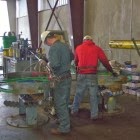According to the American Concrete
Pumping Association (ACPA), there is a heightened awareness of ACPA
certification, and as such, it has increased the demand for certified pump
operators. The ACPA states that, “certification has proven to raise the safety
awareness of operators, which can help eliminate the risk of harm when using a
concrete pump on the job site.” Last
year, the Association saw a 20% growth in their certification training program. They trained a record number of operators
despite an estimated loss of 1,000 pumps in the industry since 2006.
The program now includes a mandatory
ACPA Safety Presentation Program and there have been modifications made to the
certification test regarding security and authenticity. Furthermore, when you choose to use an ACPA certified
operator at your job site, you are in compliance with the personnel
requirements of the ASME B30.27 Safety Standard for Material Placement
Systems.
Another part of the recently
introduced ASME B30.27 includes pump operators performing an “operation test
demonstrating proficiency in handling the specific type material placement
system, including both pre-start and post-start inspection, setup procedures,
maneuvering skills, shutdown and securing procedures.” The ACPA is still looking at how this type of
extensive testing should be handled and by whom.
At The Conco Companies, every one of
our concrete pump operators are ACPA certified and are trained to operate
equipment safely and to protect those who work around the pump from harm. In addition to ACPA certification and company
specific safety training, Conco obtains inspections of all of our boom pumps
and Telebelts every year by certified boom pump inspectors. This ensures the structural integrity of the
equipment we operate. Conco has
developed and implemented some of the most rigorous pumping safety procedures
in the entire concrete industry.
The Conco Companies are a leading
supplier of concrete services for the Western United States. We have built our
reputation with superior concrete formwork, reinforcing, place and finish,
shotcrete and other ancillary services that benefit from our vast experience. With four regional offices, we serve
California, Oregon, Washington, Nevada and Colorado.
Sources:
mydigimag.rrd.com/publication/?i=253083


